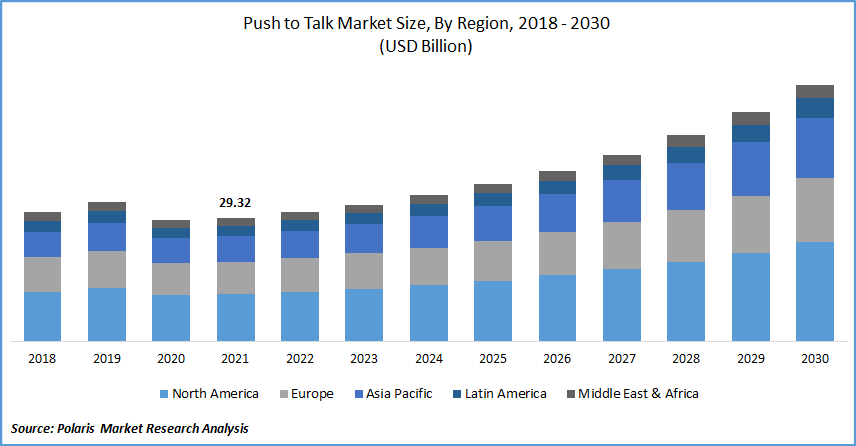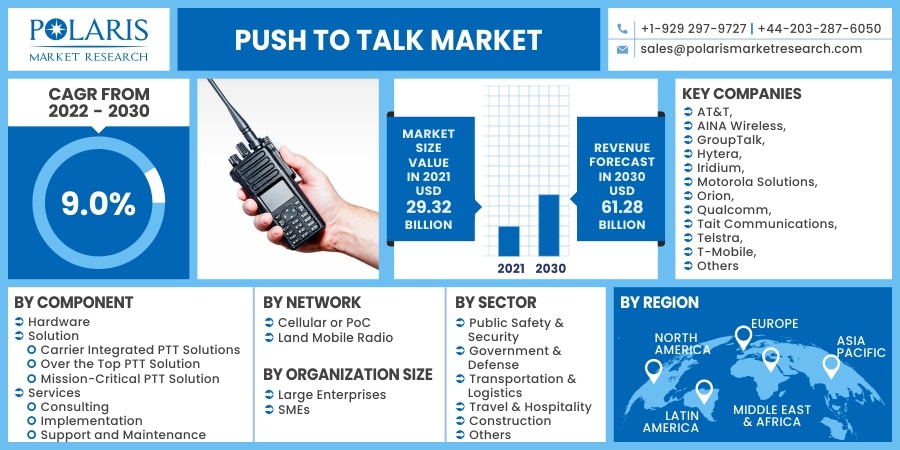
Push to Talk Market Share, Size, Trends, Industry Analysis Report, By Component (Hardware, Solution, Services); By Organization Size (Large Enterprises, SMEs); By Network (Cellular or PoC, Land Mobile Radio); By Sector; By Region; Segment Forecast, 2022 - 2030
- Published Date:May-2022
- Pages: 113
- Format: PDF
- Report ID: PM2385
- Base Year: 2021
- Historical Data: 2018 - 2020
Report Outlook
The global push to talk market was valued at USD 29.32 billion in 2021 and is expected to grow at a CAGR of 9.0% during the forecast period. Push-to-Talk (PTT) is a two-way communication provider that functions similarly to a "walkie-talkie." When comparison to cell phone calls, which seem to be full-duplex and allow both parties to hear one another, PTT is half-duplex, which indicates that communication can be transferred in one direction at a time.
 Know more about this report: request for sample pages
Know more about this report: request for sample pages
PTT necessitates that the person speaking press a specific button and then release it once finished. Following this, the listener can respond by repeating the same steps. In this manner, the system can determine which direction the information should be transferred. People can also choose who speaks and also is heard. The PTT method is most commonly found in police radios, air traffic control systems, and cellular technologies. Aside from these applications, it is used in industrial production, public safety, and transportation.
Further, various smartphone companies currently provide their customers with cutting-edge technologies and features. Larger displays, battery backup, and multi-media storage are innovations, improved communication computers, and many others. Smartphone companies are now focusing on creating specifically designed devices for Push-to-Talk Over Cellular (PoC) technology.
Also, the increased interest of public safety organizations in upgraded PTT solutions and features is expected to impact the push-to-talk market over the forecast period. The COVID-19 pandemic is expected to have little impact on the push-to-talk over the cellular market, as the popularity of push-to-talk over cellular remains high for public safety and security applications.
Push-to-talk over cellular devices is progressively used against the government and disaster management agencies in COVID-19 hotspots for communication. Push-to-talk over cellular equipment is a game-changer innovation for public-safety communications. Moreover, the emergence of advanced technologies such as the LTE network and the advancement of 5G infrastructure is anticipated to offer new lucrative opportunities, resulting in the rapid expansion of the push to talk market.
The Internet of Things (IoT), Artificial Intelligence (AI), natural language processing, and the increasing use of online applications will build tremendous opportunities for the push to talk market. As a result, the market has a huge amount of potential. However, the capital investment required to deploy land mobile radio network infrastructure type communication is anticipated to impede push to talk market growth during the forecast period.
Industry Dynamics
Growth Drivers
The transition of the LMR system from analog to digital has contributed to market growth. In January 2021, Vodafone Qatar launched Vodafone Push-To-Talk Plus, an innovative business-critical service enabled by Vodafone's GigaNet nationwide network that provides instant and encrypted communications between individuals or groups with the touch of a button. Vodafone Push-to-Talk Plus is the first walkie-talkie-like service designed.
Distributed employees can use that as an optimal situation for construction sites, ports, airfields, stadiums, malls, hotel chains, and all business owners involved in the organization and procedure of mega-events where organizations need to collaborate with real-time responsiveness. In January 2021, Cubic Corporation's business segment announced that its Vocality RoIP and M3-SE-MFGW inter-operability gateways would support its FirstNet PTT. The Vocality RoIP is unique to enable Mission-Critical Push-to-Talk (MCPTT) interoperability between LMR and LTE networks.
Further, digitized products provided a robust communication experience and increased spectrum efficiency, allowing for Machine-to-Machine (M2M) assistance and other high-end Industrial Internet of Things (IIoT) applications. Businesses can encourage voice and data services, including M2M applications, on a high-reliability network that includes the entire service region by leveraging modern electronic mission-critical LMR systems.
LMR is the first innovation developed specifically for PTT connectivity over a private network in a particular location and is still widely utilized. In addition to voice, these analog technologies enable LMR to carry a certain amount of data. Due to the enormous ruggedness of the LMR equipment and the countless fail-safe options built into the LMR radios and networks, LMR connectivity has an excellent reputation for reliability.
Due to the widespread use of LMR systems and their transition to digital LMR and assistance for voice and data services, enterprises are increasingly turning to broadband PTT for cost-effective LMR augmentation. Thus, these are boosting the market growth during the forecast period.

Know more about this report: request for sample pages
Report Segmentation
The market is primarily segmented based on component, network, sector, organization size, and region.
|
By Component |
By Network |
By Sector |
By Organization Size |
By Region |
|
|
|
|
|
Know more about this report: request for sample pages
Insight by Network
Land Mobile Radio (LMR) segment is expected to be the most significant revenue contributor in the global market. LMR has several advantages, including providing the best coverage between many wireless communication technologies and a high level of convenience and flexibility for military-grade encryption of all voice and data transmissions.
Geographic Overview
North America had the largest revenue share. North American market growth is primarily attributed to the increasing availability of public safety communication and government applications in this region, which Europe will pursue due to strict encryption regulations in the region. Furthermore, North American industries utilize push-to-talk over LTE networks to provide companies with expansive commercial coverage far greater than that funded by an individual or shared LMR network.
Moreover, Asia Pacific is expected to witness a high CAGR in the global market in 2021. Increasing demand from the transportation sector in emerging economies results from an increase in the number of vehicles on the road, high traffic density, and a lack of information channels between drivers. Push-to-talk has been used to communicate between many drivers to avoid accidents as more people use cars as a mode of transportation. The Asia Pacific region is expanding due to the region's widespread adoption of the market.
Competitive Insight
Some of the major players operating in the global market include AT&T, AINA Wireless, GroupTalk, Hytera, Iridium, Motorola Solutions, Orion, Qualcomm, Tait Communications, Telstra, T-Mobile, Verizon Wireless, Voxer, Zebra, and Zello.
Push to Talk Market Report Scope
|
Report Attributes |
Details |
|
Market size value in 2021 |
USD 29.32 Billion |
|
Revenue forecast in 2030 |
USD 61.28 Billion |
|
CAGR |
9.0% from 2022 - 2030 |
|
Base year |
2021 |
|
Historical data |
2018 - 2020 |
|
Forecast period |
2022 - 2030 |
|
Quantitative units |
Revenue in USD Million/Billion and CAGR from 2022 to 2030 |
|
Segments covered |
By Component, By Network, By Sector, By Organization Size, By Region |
|
Regional scope |
North America, Europe, Asia Pacific, Latin America, Middle East & Africa |
|
Key companies |
AT&T, AINA Wireless, GroupTalk, Hytera, Iridium, Motorola Solutions, Orion, Qualcomm, Tait Communications, Telstra, T-Mobile, Verizon Wireless, Voxer, Zebra, and Zello |
